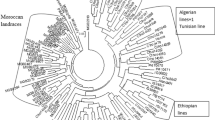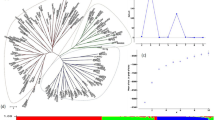Abstract
Genetic diversity and structure of populations of the wild progenitor of barleyHordeum spontaneum in Iran was studied by electrophoretically discernible allozymic variation in proteins encoded by 30 gene loci in 509 individuals representing 13 populations of wild barley. The results indicate that: a)Hordeum spontaneum in Iran is extremely rich genetically but, because of predominant self-pollination, the variation is carried primarily by different homozygotes in the population. Thus, genetic indices of polymorphismP-1% = 0.375, range = 0.267−0.500, and of genetic diversity,He = 0.134, range = 0.069−0.198, are very high. b) Genetic differentiation of populations includes clinal, regional and local patterns, sometimes displaying sharp geographic differentiation over short distances. The average relative differentiation among populations isGst = 0.28, range = 0.02−0.61. c) A substantial portion of the patterns of allozyme variation in the wild gene pool is significanctly correlated with the environment and is predictable ecologically, chiefly by combinations of temperature and humidity variables. d) The natural populations studied, on the average, are more variable than two composite crosses, and more variable than indigenous land races of cultivated barely,Hordeum vulgare, in Iran. — The spatial patterns and environmental correlates and predictors of genetic variation ofH. spontaneum in Iran indicate that genetic variation in wild barley populations is not only rich but also at least partly adaptive. Therefore, a much fuller exploitation of these genetic resources by breeding for disease resistance and economically important agronomic traits is warranted.
Similar content being viewed by others
References
Brown, A. H. D., 1978: Isozymes, plant population genetic structure and genetic conservation. — Theor. Appl. Genet.52, 145–157.
—,Munday, J., 1982: Population genetic structure of land races of barley from Iran. — Genetica58, 85–96.
—,Nevo, E., Zohary, D., 1977: Associations of alleles at esterase loci in wild barleyHordeum spontaneum. — Nature268, 430–431.
—,Zohary, D., Nevo, E., 1978a: Outcrossing rates and heterozygosity in natural populations ofHordeum spontaneum Koch in Israel. — Heredity41, 49–62.
—,Nevo, E., Zohary, D., Dagan, O., 1978b: Genetic variation in natural populations of wild barelyHordeum spontaneum. — Genetica49, 97–108.
—,Feldman, M. W., Nevo, E., 1980: Multilocus structure of natural populations ofHordeum spontaneum. — Genetics96, 523–536.
Frankel, O. H., Bennet, E., (Eds.), 1970: Genetic Resources in Plants — Their Exploration and Conservation. — Oxford: Blackwell Scient. Publ.
—, (Eds.), 1975: Crop genetic resources for today and tomorrow. International Biological Programme2. — Cambridge: University Press.
—,Soule, M., 1981: Conservation and Evolution. — Cambridge: University Press.
Harlan, J. R., 1975: Our vanishing genetic resources. — Science188, 618–621.
—,Zohary, D., 1966: Distribution of wild wheat and barley. — Science153, 1074–1080.
Kahler, A. L., Allard, R. W., Krazakowa, C. F., Wehrhahn, C. F., Nevo, E., 1980: Association between isozyme phenotypes and environment in the slender wild oats (Avena barbata) in Israel. — Theor. Appl. Genet.56, 37–47.
Marshall, D. K., Brown, A. H. D., 1975: Optimum sampling strategies in genetic conservation. — InFrankel, O. H., Hawkes, J. G., (Eds.): Crop Genetic Resources for Today and Tomorrow, pp. 53–70. — Cambridge: University Press.
Moseman, J. G., Nevo, E., Zohary, D., 1983: Resistance ofHordeum spontaneum collected in Israel to infection withErysiphe graminis hordei. — Crop Science23, 1115–1119.
-Nevo, E., El-Morshidy, M. A., Zohary, D., 1986: Reactions ofHordeum spontaneum to infection with cultures ofPuccinia hordei from Israel and United States. — Euphytica (in press).
Nei, M., 1972: Genetic distance between populations. — Amer. Natur.106, 283–292.
—, 1973: Analysis of gene diversity in subdivided populations. — Proc. Nat. Acad. Sci. U.S.A.70, 3321–3323.
Nevo, E., 1983a: Population genetics and ecology: The interface. — InBendall, D. S., (Ed.): Evolution from Molecules to Man, pp. 287–321. — Cambridge: University Press.
- 1983b: Genetics resources of wild emmer wheat: structure, evolution and application in breeding. — Proc. Sixth Intern. Wheat Genetics Symposium, Kyoto, Japan, 1983, 421–431.
—,Brown, A. H. D., Zohary, D., 1979a: Genetic diversity in the wild progenitor of barley in Israel. — Experientia35, 1027–1029.
—,Zohary, D., Brown, A. H. D., Haber, M., 1979b: Genetic diversity and environmental associations of wild barleyHordeum spontaneum in Israel. — Evolution33, 815–833.
—,Brown, A. H. D., Zohary, D., Storch, N., Beiles, A., 1981: Microgeographic edaphic differentiation of allozyme polymorphisms of wild barley. — Pl. Syst. Evol.138, 287–292.
—,Golenberg, E. M., Beiles, A., Brown, A. H. D., Zohary, D., 1982: Genetic diversity and environmental associations of wild wheat,Triticum dicoccoides in Israel. — Theor. Appl. Genet.62, 241–254.
—,Lavie, B., Ben-Shlomo, R., 1983a: Selection of allelic isozyme polymorphisms in marine organisms: patterns theory and application. — InRatazzi, M. C., Scandalios, J. G., Whitt, G. S., (Eds.): Isozymes: Current Topics in Biological and Medical Research,10, pp. 69–92. — New York: Liss Publ.
—,Beiles, A., Storch, N., Doll H., Andersen, B., 1983b: Microgeographic edaphic differentiation in hordein polymorphisms of wild barley. — Theor. Appl. Genet.64, 123–132.
—, —,Ben-Shlomo, R., 1984a: The evolutionary significance of genetic diversity: Ecological, demographic and life history correlates. — InMani, G. S., (Ed.): Evolutionary Dynamics of Genetic Diversity. — Lecture Notes in Biomathematics53, 13–213.
—,Moseman, J. G., Beiles, A., Zohary, D., 1984b: Correlation of ecological factors and allozymic variations with resistance toErysiphe graminis hordei inHordeum spontaneum in Israel: patterns and application. — Pl. Syst. Evol.145, 79–96.
—,Beiles, A., Gutterman, Y., Storch, N., Kaplan, D., 1984c: Genetic resources of wild wheat cereals in Israel: I. Phenotypic variation within and between populations of wild wheat,Triticum dicoccoides. — Euphytica33, 717–735.
Nevo, E., Beiles, A., Gutterman, Y., Storch, N., Kaplan, D., 1984d: Genetic resources of wild cereals in Israel: II. Phenotypic variation within and between populations of wild barley,Hordeum spontaneum. — Euphytica33, 737–756.
—,Moseman, J. G., Beiles, A., Zohary, D., 1985: Patterns of resistance in wild wheat to pathogens in Israel: I. Predictive method by ecology and allozyme genotypes for powdery mildew and leaf rust. — Genetica67, 209–222.
—,Zohary, D. Beiles, A., Kaplan, D., Storch, N., 1986a: Genetic diversity and environmental associations of wild barley,Hordeum spontaneum, in Turkey. — Genetica68, 203–213.
—,Beiles, A., Zohary, D., 1986b: Genetic resources of wild barley in the Near East: Structure, evolution and application in breeding. — Biol. J. Linn. Soc.27, 355–380.
Ohta, T., Cockerham, C. C., 1974: Detrimental genes with partial selfing and effects on a neutral locus. — Genet. Res.23, 191–200.
Plucknett, D. L., Smith, N. J. H., Williams, J. T., Anishetti, N. M., 1983: Crop germplasm conservation and developing countries. — Science220, 163–169.
SPSS-x, 1983: User's Guide. — New York: McGraw Hill Co.
Thomson, G., 1977: The effect of a selected locus on linked neutral loci. — Genetics85, 753–788.
Wright, S., 1965: The interpretation of population structure by F-statistics with special regard to systems of mating. — Evolution19, 395–420.
Zohary, D., 1969: The progenitors of wheat and barley in relation to domestication and agricultural dispersal in the Old World. — InUcko, P. J., Dimbleby, G. W., (Eds.): Domestication and Exploitation of Plants and Animals, pp. 47–66. — London: The Gerald Duckworth & Co.Ltd.
Author information
Authors and Affiliations
Rights and permissions
About this article
Cite this article
Nevo, E., Beiles, A., Kaplan, D. et al. Genetic diversity and environmental associations of wild barley,Hordeum spontaneum (Poaceae), in Iran. Pl Syst Evol 153, 141–164 (1986). https://doi.org/10.1007/BF00983683
Received:
Issue Date:
DOI: https://doi.org/10.1007/BF00983683




